Jump to:
Wondering about the difference between balayage vs highlights? It’s important to know about these two popular hair lightening techniques so you end up with the look you want. Learn the differences below.
Balayage vs Highlights: What’s the Difference?
Balayage and highlights have a lot in common, but an important difference sets the two apart. Balayage is a technique where color (or bleach) is hand-painted onto strands for a natural, sweeping look. Highlights involve lightening small sections of hair from the root to the tip using foils.
Since balayage has become so trendy, it’s one of the top-requested services in salons.
But if you’re used to getting regular foil highlights, the look a balayage technique will give you can be a lot different than you expect. And if you’re after a traditional highlighted look, asking for balayage highlights could leave you disappointed.
That’s why it’s essential to know what makes balayage and highlights different, what the finished results look like with each, the cost differences, and what each look is best for. If you’ve been confused about the difference between balayage vs highlights, you’re in the right place.
The Short Answer:
| Balayage | Highlights |
|---|---|
| Natural, sun-lightened look | Overall lighter look |
| Subtle, sweeping color | More obvious pattern |
| Lightener hand-painted midway down strands | Lightener painted root to tip on foiled sections |
| Roots left natural | Roots are lightened |
| Difficult to lift hair to high levels | Easier to lift hair to high levels |
| Produces red undertones in dark hair | Easily removes red tones in dark hair |
| Maintenance every 3-6 months | Maintenance every 6-8 weeks |
| Costs $100-$150+ | Costs $20-$150+ |
The Long Answer:
Whether you want to add in platinum, strawberry blonde, or a deep caramel color, either of these lightening techniques could be the way to get the results you want. Find out if it’s really balayage or highlights you want by learning all about each in our guide.
What Is Balayage?
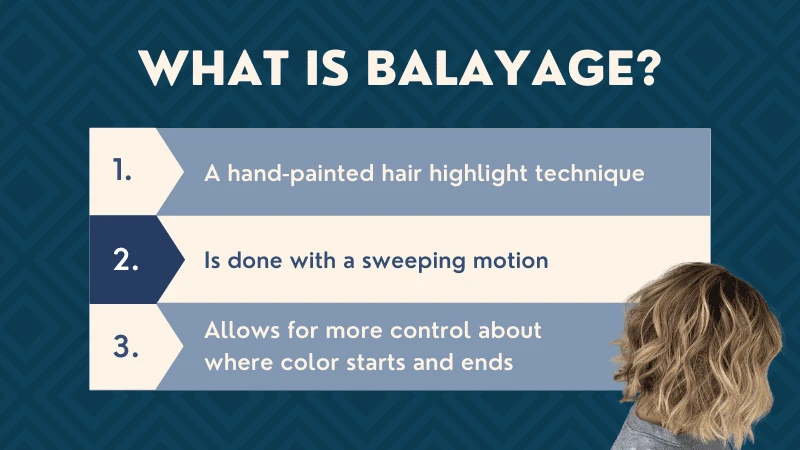
Balayage comes from a French word meaning “to sweep.” That makes sense because the balayage lightening technique involves hand-painting or “sweeping” lightener onto strands in a natural pattern.
If you watch a skilled stylist use the balayage technique, they actually use a flicking or sweeping motion with the color brush as they artfully apply bleach to avoid harsh lines and patterns.
Typically, balayage begins midway down the strands and avoids the root area. When the balayage technique is used, lightener is applied very minimally to small strands just beyond the roots, then gradually increased down the length of the hair for a well-blended look.
Because balayage doesn’t lighten your roots, this technique gives you more time between visits and less overall maintenance (no roots showing). It mimics the look of naturally sun-lightened hair.
One thing that draws so many women to the balayage technique is the level of multidimensional color it gives. Instead of harshly patterned sections, lighter strands are subtly and expertly woven in with your natural, darker color for a truly natural and eye-catching result.
What Are Highlights?
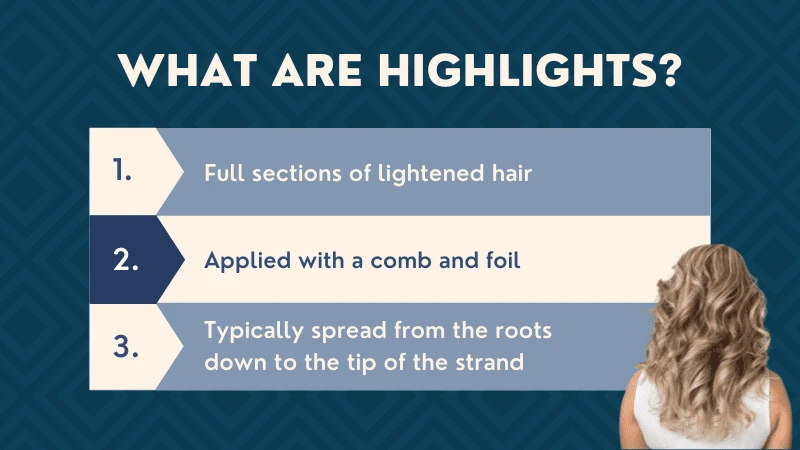
Traditional full highlights are a familiar sight for most of us – you’ll see lightened sections of hair in a pattern of strips in varying widths. The width of highlights is a matter of personal preference.
Large, chunky highlights were popular in the 00s, but thinner, more natural highlights are usually preferred today.
Typically, highlights are done using foils. A stylist uses a special comb to weave small sections of hair out, apply lightener to them, and seal the treated section in foil to help contain the lightener, keep it moist, and shorten the processing time.
Natural hair is usually left unlightened between each foil section to help blend the highlighted hair in with the rest. However, a colorist may choose to place a different color on the hair left outside of the foils in order to cover gray or change the overall look of the color. It is not uncommon for a colorist may choose to use a combination of multiple colors and application techniques to create a truly customized look for each client.
While the results and application techniques can vary, one thing doesn’t change, highlights will always leave you with lightened strips of hair from the root to the tips.
Highlights have a lot of variances because the technique and highlighting pattern used all affect the end result. You’ll see many different types of highlights, but some of the most common include:
- Babylights. Subtle highlights done around the face to mimic the way sun naturally lightens face-framing hair on a child
- Partial highlights. Up to 20 foils are used to lighten hair in strategic areas like the roots, hairline, and crown
- Full highlights. Foils are applied all over the head to achieve an overall lighter look from root to tip, with some natural hair color peeking through for dimension
- Cap highlights. Hair is pulled through a special highlighting cap to result in an overall lighter look with a more random pattern than foils
In most cases, traditional highlights require the hair to be sectioned before lightener is applied. This results in a more patterned look that is less natural.
Balayage Vs Highlights
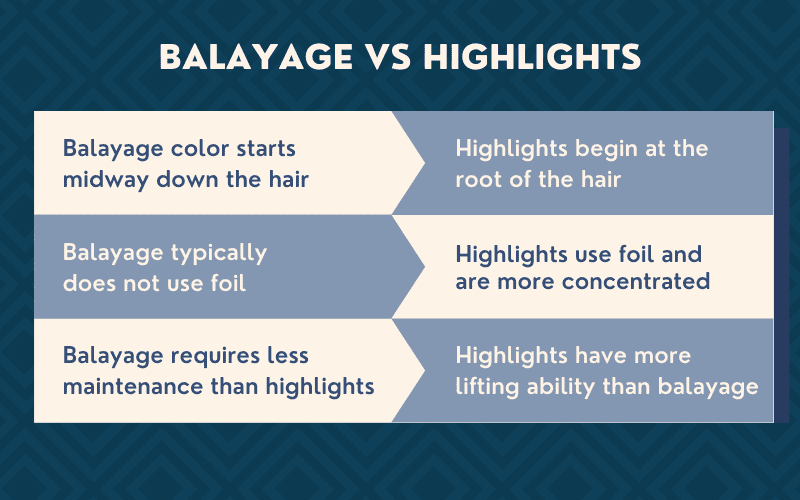
Now that we’ve seen what balayage and highlights are, let’s focus in on the differences between these two lightening services.
Application Technique
The main difference between balayage vs highlights is that balayage is done by hand while highlights are done using small sections woven out from the hair, painted with lightener, and covered with foils.
Since balayage color is hand-painted onto the hair with a light hand, there are no harsh lines or obvious patterns in the lightened sections. In the balayage technique, lightener is not applied to the roots.
Instead, very fine strands are lightened just below the roots and gradually increase down the length of the hair. There is no clear line of where the lightened areas start or stop with balayage.
But highlights are a little more rigid. The stylist must section the hair out, weave small strands of hair out of each section to lighten, and apply bleach from the roots to the tips of hair before covering it with a foil.
This is why highlights are more expensive to maintain than balayage – you’ll start seeing roots showing through within about six weeks.
Lightening and Toning Ability
Balayage creates a natural, gorgeous look that is more easily maintained and on-trend, but foil highlights do have some advantages over the balayage technique.
First, if you have dark hair and want to lighten it up, foil highlights can reliably lift your dark color to the right level for toning. But with balayage on darker hair, you have to use a higher volume developer to get the same kind of result because there’s no foil to help processing along.
That means more damage for your strands during each visit. Second, foil highlights give your stylist the most control over the resulting tone of your hair. Because the foils help hair process evenly and quickly, any red undertones that peek out during the lightening process can easily be processed out.
Then, the toner can be applied to give you the finished look and color you want. But without foils, the balayage technique doesn’t leave your stylist as much control over the resulting tone of your hair.
Unless a very high volume developer is used (which penetrates your strands more deeply and damages the hair more), any undertones that popped out during processing can be hard to tone and hide.
Hair Damage
We mentioned the limitations of balayage in lifting dark hair to lighter levels. That can be corrected by using a higher volume developer, but doing so lifts the hair cuticle more. That increases the hair’s exposure to the lightener, which damages the hair shaft.
Using too high of a developer volume can also prevent the cuticle from laying back down. A raised cuticle layer not only damages the hair on a molecular level, but also leaves the hair open to more damage and breakage from the elements, heat styling, and even regular washing and brushing.
On the other hand, highlights don’t need to use a high-volume developer to properly lift the hair to the desired level of lightness.
The use of foils insulates the hair as it lightens, trapping heat and shortening processing times. That results in less damage to the hair overall with highlights, even considering that more maintenance visits are required to keep the look fresh.
Cost of Balayage vs Highlights
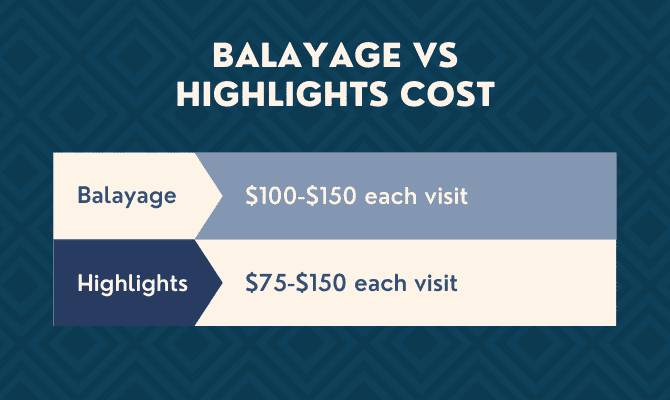
Another big difference between balayage and highlights is the cost. Balayage services typically cost more than highlights because they’re more time consuming and require expertise to properly hand paint and blend each section.
In our survey of salons across the U.S., we found that the average cost for balayage was anywhere from $100 to $150. The cost goes up for long or very thick hair.
Full foil highlights are also time consuming, and stylists must work quickly to avoid overprocessing the first foiled sections as they work around the head.
But full foil highlights are usually cheaper than balayage services at an average cost of $75 to $150. Like babylights and partial highlights, highlights on smaller sections can cost as little as $20 to around $55.
Similarities Between Balayage vs Highlights
While there are plenty of differences in the battle of balayage vs highlights, there are some overlapping areas. Both services involve lightening sections of the hair. Both involve leaving some sections of the natural hair to add dimension and blend the lighter and darker sections together.
And sometimes, balayage and highlights are combined into a service called “foiliage.” This involves hand-painting lightener onto strands like balayage.
But instead, foils are used to close lightened sections up for faster processing and less bleed-over onto unlightened hair. You still get the natural, more subtle look and pattern of balayage, but since foils are used, the hair can be lifted more than three levels and at a faster rate.
For this reason, many stylists opt for the foiliage technique on clients with darker hair that will have trouble lifting to the right level for toning. Many like this method because it lifts quicker and results in less damage to the hair.
Balayage or Highlights: Which Are Right For You?
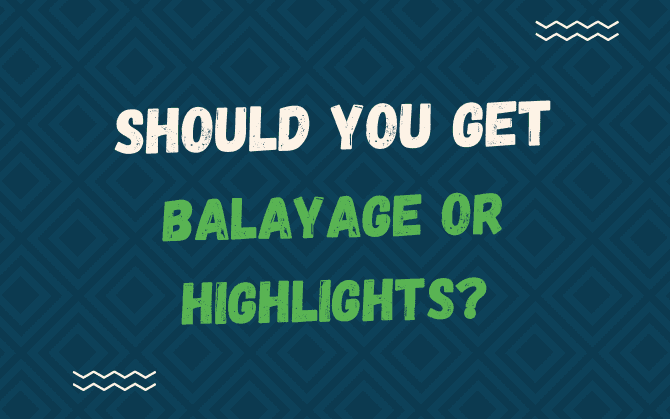
We’ve compared and contrasted balayage vs highlights. So which of these hair lightening services will be the right choice for you? That depends on a few factors.
- What look are you going for? If you want a natural, subtle look, you want balayage or foiliage. These techniques result in softly sweeping light sections that mimic sun-lightened hair and have no obvious pattern. If you want an all-over lighter look or lightened hair in strips or patterned sections, foil highlights will be the best choice.
- What color is your natural hair? If your natural color is lighter, balayage is a perfect choice to get lighter sections that look natural. But darker natural color needs a little help lifting to higher, lighter levels. Hand-painted balayage without foils isn’t the way to get to a white or ash blonde if you have very dark hair. Foil highlights or foiliage techniques are best for darker hair colors because they reliably lift the hair more than three levels in a much shorter time period.
- How damaged is your hair? If your hair is already reeling from damage from chemical processing or heat styling, you need to keep this in mind as you decide between balayage vs highlights. If you have dark, damaged hair, balayage will require too high a developer to properly lighten it – and that will guarantee more damage to your locks. Avoid piling on the damage by opting for foiliage or foil highlights instead.
- What’s your budget? If you want to keep things as cheap as possible, highlights are going to be your best bet. You can get face-framing babylights for as little as $20 in a salon, and partial highlights to brighten sections of hair may cost you around $55. Full foil highlights and balayage are more expensive, with full highlights starting at around $75 in most salons and balayage at about $100.
Overall, balayage and highlights offer two completely different looks because they use different techniques to apply lightener and lift the hair color. If you want natural and subtle lightened hair with minimal maintenance, balayage might be right for you.
If you want hair that looks lighter overall and don’t mind root touchups every 6-8 weeks, look into getting foil highlights instead. You probably have a good idea of the look you want.
The next step is having a quick consultation with your stylist to find out which technique can be used to achieve the look you want with minimal damage to your locks. Don’t have a stylist? No problem. Use our salon directory to enter your zip code and find top-rated salons near you.
